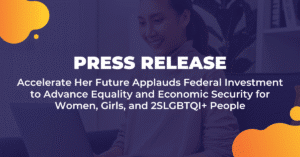

Photo by Christina Morillo, Pexels
In the hustle and bustle of workplaces, many organizations pride themselves upon their equity, diversity, and inclusion strategies. Although commendable, one may wonder why it is so rare to find Indigenous, Black, and racialized women in leadership positions? As early-career racialized women ourselves, we often reflect on advancement opportunities for those of us from racialized backgrounds. As we navigate our careers and aspire to climb up the ladder, we see fewer and fewer people who look like us.
In the landscape of today’s workplace, Indigenous, Black, and racialized women navigate unique challenges and biases on their journey to advancement and senior leadership roles. Despite their competence and potential, Indigenous, Black, and racialized women often find themselves overlooked for promotions, leaving them sidelined. According to the Sponsor Effect: Canada report by Ritu Bhasin et al, men are more likely to be recommended for high-profile positions by senior leaders. Moreover, women are outnumbered by men not only at the highest senior levels, but also throughout the journey to the top and within mid-level ranks.
Here’s a striking finding: The Globe and Mail looked at records from the Canadian public sectors and discovered that of the top-earning employees, only 3 percent were racialized women. Zooming in, we can observe a more stark and concerning reality. In the country’s major centres, the Diversity Institute reports that white women significantly outnumber racialized women in corporate leadership roles – in Toronto, that ratio is 7:1. What is more, Dr. Wendy Cukier, the founder and academic director of the Diversity Institute mentions that although the wage gap is narrowing, women still earn 87% of what men earn, with this gap being more pronounced in racialized women (67%) and Indigenous women (65%).
One of the barriers faced by women in leadership settings is what’s known as ‘The Goldilocks Dilemma.’ This phenomenon states that women in leadership positions are constantly scrutinized for their leadership styles. They are trapped in an impossible standard labelled as either “too emotional” or “too detached”, “too assertive” or “not assertive enough”. The constant tugging and pulling chips away at their confidence, further perpetuating the cycle of underrepresentation.
Dr. Fatima Cody Stanford of Harvard Medical School interestingly states that the Goldilocks dilemma is often intertwined with intersectional identities. She mentions that Black women encounter a version of the Goldilocks dilemma: “They are either insufficient and unsuitable, or boastful and overdone – never just right.”
Existing narrow models of leadership overlook the qualifications and competence of Indigenous, Black, and racialized women as prospective leaders. According to Dr. Rosalind Chow’s HBR article titled “Don’t Just Sponsor Women and People of Color — Defend Them”, when women are increasingly represented in leadership positions, a ripple effect occurs, enhancing diversity throughout the organization. This is known as the ‘trickle-down’ diversity phenomenon. Appointing a woman CEO has been linked to increased representation of women in leadership positions.
Acknowledging the need to create the conditions for Indigenous, Black, and racialized women to thrive in workplaces has never been more important. The concept of sponsorship is central to the advancement of Indigenous, Black, and racialized women. Sponsorship emphasizes equity in workplaces. It is the recognition that Indigenous, Black, and racialized women are underrepresented in senior level positions due to the presence of implicit and explicit biases and other inequities at different levels of their journey. Sponsorship is the action.
Now, you must be wondering, what exactly is sponsorship, and how can it help women advance in the workforce? Let’s dive right in.
In a nutshell, sponsorship is about leveraging one’s position of power to facilitate an individual’s career advancement. In this case, a sponsor would actively vouch for and facilitate the advancement of an Indigenous, Black, or racialized woman in the workplace.
Sponsorship is often misconstrued as synonymous to mentorship. In reality, sponsorship is distinct from mentorship. A mentor provides guidance, advice, and feedback. It’s a relationship deeply rooted in the personal and professional development of the mentee, focusing on building skills, enhancing confidence, and navigating the intricacies of workplace dynamics. One can consider mentors as ‘advisors’, who guide based on their own experiences. This type of relationship is invaluable for personal growth.
When it comes to advancing in one’s career, sponsorship introduces a different, arguably more impactful, dimension of support for women. Unlike mentorship, sponsorship is outward-facing and action-oriented. Sponsors do not just advise; they connect and advocate. They use their influence and social capital to actively advocate for Indigenous, Black, and racialized women, ensuring that they gain visibility, recognition, and opportunities for advancement especially within senior positions. They open doors to high-profile projects, endorse them for promotions, and introduce them to influential networks. While you may think of mentors as ‘advisors’, think of sponsors as ‘publicists’.
Mentorship without sponsorship may not be sufficient to propel Indigenous, Black, and racialized women into leadership roles or through significant career milestones. Sponsorship is crucial, if not necessary, in breaking down the barriers for women’s advancement in the workplace, including those stemming from systemic biases and lack of visibility.
According to the Sponsor Effect: Canada Report, only 1% of women of color in Canada have reported to have a sponsor in their workplace. sponsorship is rare in Canada.
Among the sponsorship endeavors that do exist here, sponsors, who are often white men, are reported to sponsor individuals that look like them. The report also states that 74% of men in senior positions indicate that their sponsors are of the same gender, and 66% report that their sponsors are of the same race.
Men are part of the solution. Leveraging men’s power, influence and privileged position in decision-making processes requires their allyship and sponsorship for Indigenous, Black, and racialized women.
One misconception and barrier to effective sponsorship is that it has to be all-or-nothing, creating a binary mindset: either completely refrain from sponsoring or commit fully if you choose to do so. In her HBR article titled “A Lack of Sponsorship Is Keeping Women from Advancing into Leadership”, Herminia Ibarra clarifies that approaching sponsorship with such a mindset is detrimental, creating a fear of commitment. It can be costly for those in senior roles to sponsor women, therefore seeing it as an all-or-nothing can hold them back.
According to Ibarra, sponsorship should be thought of as a continuum; you can commit to Indigenous, Black, and racialized women on varying levels from private and passive, to active and public. Not only is this approach more effective in supporting the advancement of Indigenous, Black, and racialized women, but it makes leaders more inclined towards sponsorship as the continuum provides a less daunting approach.
According to Ibarra, the continuum includes the following roles with mentors at one end and advocates at the other:
It is a dedicated responsibility to Indigenous, Black, and racialized women to recognize the privileges one owns within senior positions, and then work towards moving towards the sponsorship behaviours in the continuum.
Similarly, another way to look at sponsorship is through its ABCDs, according to Dr. Rosalind Chow. The ABCDs of sponsorship are as follows: amplifying, boosting, connecting, and defending. As a connector, opportunity giver and advocate, leaders can amplify women’s voices, boost their accomplishments and connect them to influential networks. Defending is where advocating and active allyship behaviours come in, when women are criticized unjustly. More men are needed in defending and advocating given their power and decision making influence within organizations.
How can sponsorship be practiced specifically in real life? Would it reap benefits? Let’s walk through how leaders can implement sponsorship within their workplace.
It is leaders’ duty to take time to build relationships with and hear the voices of Indigenous, Black and racialized women in the organization. Sponsorship can be practiced by first listening (really listening) to Indigenous, Black, and racialized women – real-time conversations and asking questions to better understand their experiences and needs.
Amplifying their voices on various workplace communication platforms is essential so that their voices and stories are heard. Additionally, leaders can amplify their voices by conveying their sentiments in their speeches, articles, and conversations with organizations.
As senior leaders, it is imperative to work towards playing roles of strategizers, connectors, opportunity givers, and advocates. The next time there’s a promotion opportunity within the organization, ask whether the pool of potential candidates is diverse? Does it include women, especially Indigenous, Black or racialized women?
Make Indigenous, Black, and racialized women aware of stretch projects, advancement and promotion opportunities, and aid them along the way to prepare and support them throughout the process. Speak their names in spaces and tables where decisions are being made.
Lastly, and perhaps most importantly, leaders must advocate for Indigenous, Black, and racialized women. For example, imagine hearing a microaggression or harmful bias in a conference meeting. An advocate takes personal responsibility to take appropriate actions in or outside the meeting to address harmful behaviours.
Sponsorship is a form of intentional and active allyship. Through meaningful action leaders stand in solidarity with Indigenous, Black and racialized women. Using power and influence to create a more equitable workplace where all women can flourish and thrive.
As early-career racialized women, we channelled our curiosity and personal experiences into writing this important piece, shedding light on the barriers that Indigenous, Black, and racialized women face as they enter workplaces and aspire to advance. Navigating our own professional paths as racialized women, we find profound strength in illuminating these challenges and solutions to establishing a more empowering and equitable foundation in the country for Indigenous, Black, and racialized women in workplaces. Recognizing the inequitable access to leadership roles for Indigenous, Black, and racialized women is crucial. Leaders are in a unique position to catalyze change through bold action.
References:
Chow, R. (2021, September 17). Don’t Just Mentor Women and People of Color. Sponsor Them. Harvard Business Review. https://hbr.org/2021/06/dont-just-mentor-women-and-people-of-color-sponsor-them
Chow, R. (2023, February 14). Don’t Just Sponsor Women and People of Color — Defend Them. Harvard Business Review. https://hbr.org/2023/02/dont-just-sponsor-women-and-people-of-color-defend-them
Doolittle, R., & Wang, C. (2021, January 21). This is the Power Gap: Explore the investigative series and data. The Globe and Mail. https://www.theglobeandmail.com/canada/article-power-gap/
Ibarra, H. (2021, January 20). A Lack of Sponsorship Is Keeping Women from Advancing into Leadership. Harvard Business Review. https://hbr.org/2019/08/a-lack-of-sponsorship-is-keeping-women-from-advancing-into-leadership
MacNeill, A. (2021, November 18). Being a doctor is hard enough. Being a Black woman doctor is its own challenge. Boston News. https://www.boston.com/news/local-news/2021/11/18/black-woman-doctors/
Najibzadeh, A. (2023, August 23). Mentoring as a pathway to more equitable organizations. Women of Influence. https://www.womenofinfluence.ca/2021/01/06/mentoring-as-a-pathway-to-more-equitable-organizations/
Bhasin, R., Sherbin, L., & Kennedy J. (2021). Sponsor Effect: Canada – Executive Summary. Seyfarth Shaw LLP. https://www.seyfarth.com/a/web/59726/SponsorEffectCanada-ExecSumm-CTI-1.pdf
Toronto Metropolitan University Diversity Institute. (2020, August). Diversity Leads 2020: Canada. Toronto Metropolitan University. https://www.torontomu.ca/diversity/reports/DiversityLeads_2020_Canada.pdf
Toronto Metropolitan University Diversity Institute. (2023, March 23). How to address the underrepresentation of women in leadership. Toronto Metropolitan University. https://www.torontomu.ca/diversity/news-events/2023/03/how-to-address-the-underrepresentation-of-women-in-leadership/